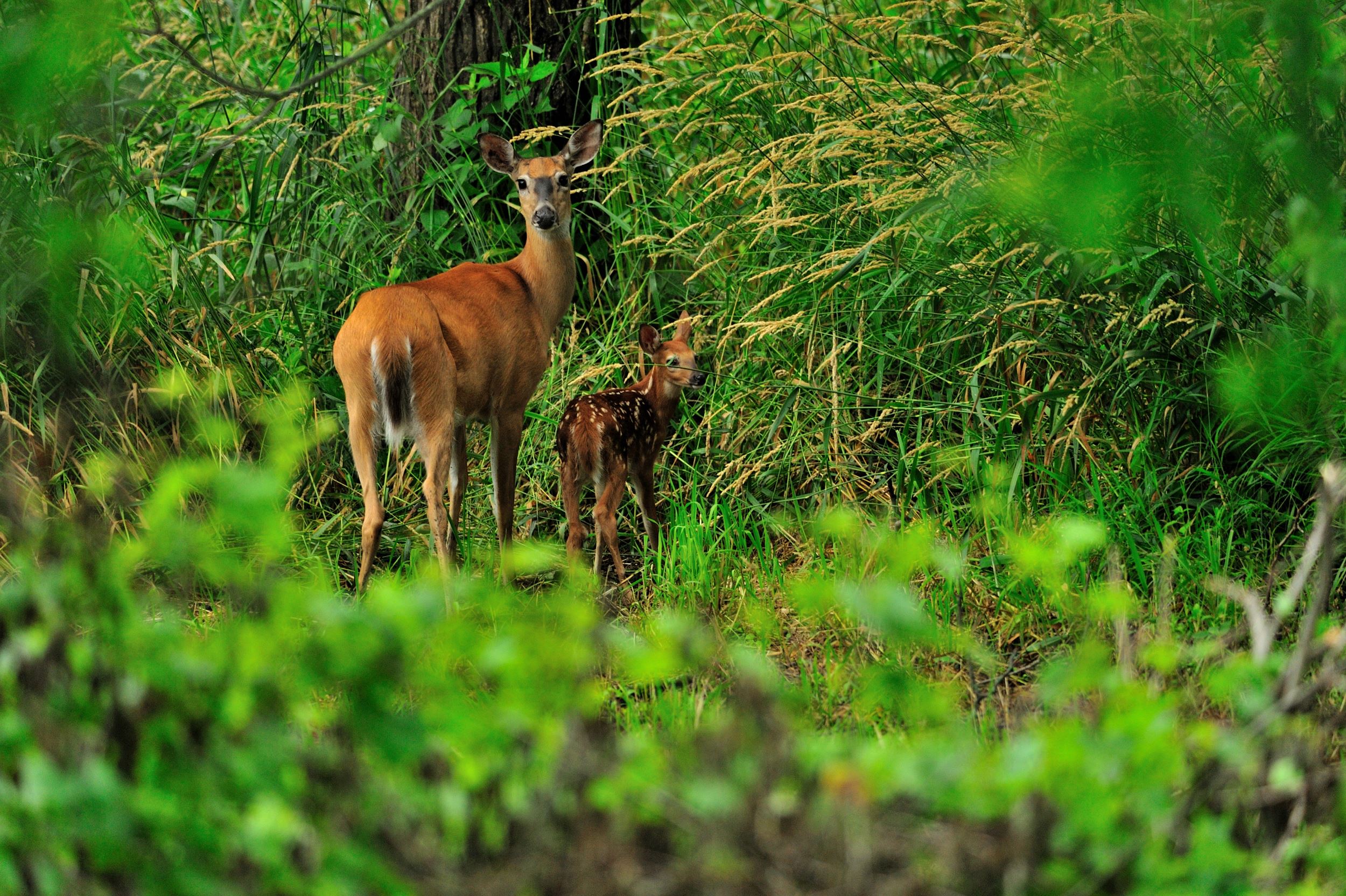Vital Refuge
By Rowan McMullen Cheng on August 19, 2019 in Blog
Iowa has experienced some tremendous landscape changes. Elk and bison herds once thundered through seas of grass, but habitat loss and over-hunting extirpated these and other native species in Iowa. However, thanks to concerted efforts to protect, restore and re-establish wildlife populations previously threatened or lost to the state – and their habitats – several native species have made a comeback.
Fawned of Whitetails
 |
| White-tailed deer watch from a lush forest- the doe making sure her fawn can safely feast on nearby foliage. Photo by Ron Huelse. |
Though it may seem hard to believe now, in the early 1900s, white-tailed deer had all but eliminated in Iowa due to overhunting. Deer season was legally closed in 1898. Over the next half decade, the population slowly but steadily stabilized, buoyed by deer that immigrated or were relocated from herds from surrounding states, as well as deer that escaped or were released from captive herds. By the early 1950, the population had reached a level that eventually led the state to reinstate the first modern deer season in 1953.
Since then, careful, localized population management has been key. With varying population sizes, habitat carrying capacities and human cultural differences, the Iowa Department of Natural Resources (Iowa DNR) manages white-tailed deer populations on small, local scales that fit deer, human and habitat needs.
“What’s so successful about the white-tailed deer is that they’re probably the most visible megafauna that we have in the state,” said DNR Wildlife Biologist Jim Coffey.
Take Flight
 |
| Trumpeter cyngets, or young swans, splash around. Since DNR reintroduction efforts, many more healthy cyngets have been born in Iowa. Photo by Deb Shoning. |
One of the most iconic species on Iowa’s landscape, the Trumpeter swan was extirpated due to overhunting and habitat loss. Though many still struggle due to limited wetland habitat, Trumpeter swans are now considered a success in Iowa thanks to an active DNR reintroduction program with support from private landowners and partners.
“The pair bonds are very strong and the idea is to raise them in an area that they will recognize then return to since they have what’s called site fidelity, or the inclination to come back to the same place year after year after year,” said Iowa State University Natural Resource and Ecology Management Professor Emeritus Jim Pease.
For the first time since near extinction over a century ago, Trumpeter swans are now producing healthy cygnets – baby trumpeter swans – in the state each year.
River Otter Rebound
 |
| River otter release at Lake Red Rock in 1985. Reintroduction efforts included releasing over 300 river otters to help the species rebound to sustainable population levels. Photo courtesy of the Iowa DNR. |
Other than in northeast Iowa, which maintained a small remnant population, river otters all but disappeared from Iowa in the late 1800s due to trapping pressure, habitat loss and food scarcity as wetlands and marshes were drained for agriculture.
“We shouldn’t work against nature, we should work with nature,” said DNR Wildlife Biologist Vince Evelsizer.
The Iowa DNR’s Wildlife Diversity Program was key to reintroduction efforts, as was the river otter’s relatable playfulness, which helped garner broad support for reintroduction. After a creative arrangement between Iowa, Kentucky and an otter farmer in Louisiana that traded two wild turkeys for every river otter (Iowa State law would not allow for the direct purchase of the otters and Kentucky was in need of wild turkeys), the first sixteen river otters were released at Red Rock in 1985. Over the years, more than 300 river otters were released at 25 different sites across the state. With steady community support, river otter populations naturally increased to the point that DNR could safely introduce a trapping season in 2006.
Butterfly Abundance
.jpg) |
| Photo by Ray Moranz |
The Regal fritillary was once found statewide, but now resides primarily in southern Iowa. Listed as a species of Special Concern by the Iowa DNR, these velvety butterflies are doing well in Iowa compared to other states within their range.
The population declined due to habitat loss. Without its larval host plant, prairie violets, an uncommon species even in high-quality reconstructed prairies, these stunning butterflies are doomed.
“It’s really important to find the remnants and protect them,” said Xerces Society Farm Bill Pollinator Conservation Planner Sarah Nizzi. “That’s most likely where you’ll find the violets and that’s the best opportunity for them.”